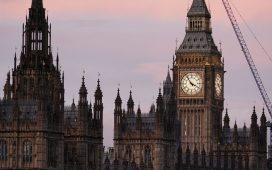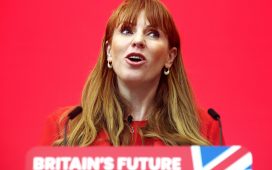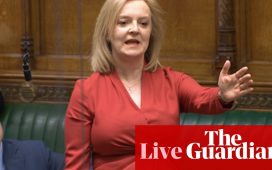
The latest headlines in your inbox twice a day Monday – Friday plus breaking news updates
Land on Park Lane in a game of Monopoly and you risk having to pay £1,500 — the second-highest on the board. Drive down the street in real-life London in a throbbing V12 Lamborghini Aventador (on sale from around £260,000) and you’ll get off scot-free. The road is just outside the congestion charge zone, even though by any measure it’s a core route through central London.
At least, it’s outside the charge zone for now. The boundaries of the congestion charge are the new front line in a smouldering conflict between the Government in Westminster — led by the last mayor of London, Boris Johnson — and City Hall, led by the current one, Sadiq Khan. This fight is personal, it has massive implications for everyone who lives and works in the city, and even those involved in the conflict admit that it makes little political sense for either side.
An exchange of letters between the Transport Secretary Grant Shapps and Mr Khan, leaked to the Financial Times the other day, shows that the Government wants TfL to find new ways to raise money and cut costs in return for more taxpayer support. The letters suggest that a much bigger C-charge, which would cover Park Lane and a lot more besides, is the sort of thing that should be introduced to keep Covid-hit TfL open.
At the moment TfL is running on empty: it’s been given two short-term bailouts from the Treasury so far, the latest of which expires formally at the end of next week. If nothing is agreed by then, in theory TfL will pull the off switch on the Tube and stick to running the few services that it is required to operate by law — school buses and, bizarrely, Woolwich ferry.
This would be an urban armageddon and in the real world it’s not going to happen. TfL has enough in the bank to stay open for a bit longer, even if a deal isn’t agreed. Tube use, which dropped to about five per cent of normal levels at the lowpoint of lockdown, is now 32 per cent of normal. Bus use is 54 per cent of normal. Both have fallen seven per cent since Tier 2 rules came in. But things like the higher £15 C-charge, which came in 24/7 in return for the first bailout are bringing in cash, too.
Nonetheless, the Government and Mayor are going eyeball to eyeball and we are all caught in the middle. This week the PM claimed that his successor as mayor “had effectively bankrupted TfL before coronavirus had even hit and left a massive black hole in its finances”. Khan howled back that he’s being asked to make “draconian” cuts to things Londoners have come to rely on — such as free travel for over 60s.
The row about the C-charge has hit the news — and that’s understandable. If a bigger charge happens, millions of people preparing for the extension of the Ultra-Low Emission Zone next year might suddenly find themselves facing the C-charge on top of that. That could mean paying £15 to use even a low-pollution car in a huge part of London from the south to the north circulars.
It’s no wonder the idea has sent London Tory MPs into uproar. After all, their mayoral candidate Shaun Bailey — likeable, ineffectual and heading for a massive defeat when the delayed election takes place next May — has made delaying the extension of the Ulez one of his campaign themes. Now a government led by his own party seems to want a bigger capital-wide road tax.
But this battle goes a lot wider than just a charge to drive. In the end, it comes down to how our transport system is funded and who controls decisions about it.
TfL, almost uniquely for a big-city transport authority, runs — or at least ran — with no day-to-day tax subsidy. Under a deal struck by Mr Johnson as mayor (declaration: I was in the room as a government advisor when it happened), the government agreed to give TfL cash for big new investment schemes, such as Crossrail, while leaving fare payers to fund day-to-day running costs — such as the big salaries it pays many staff, including Tube drivers, who start on almost £60,000 a year for a job some say could be done by a computer instead.
When TfL carried millions of people in a booming city, it managed to use fares to pay its way. But Covid has slashed its income as people stay at home, while leaving the cost of running the system almost unchanged. Without a bailout, it’s going bust.
London’s West End wipeout during Tier 2 Coronavirus Alert
1/20
Jeremy Selwyn
2/20
Jeremy Selwyn
3/20
Jeremy Selwyn
4/20
Nigel Howard
5/20
Jeremy Selwyn
6/20
Jeremy Selwyn
7/20
Nigel Howard
8/20
Nigel Howard
9/20
Jeremy Selwyn
10/20
Nigel Howard
11/20
Nigel Howard
12/20
Nigel Howard
13/20
Nigel Howard
14/20
Nigel Howard
15/20
Jeremy Selwyn
16/20
Jeremy Selwyn
17/20
Jeremy Selwyn
18/20
Jeremy Selwyn
19/20
Jeremy Selwyn
20/20
Jeremy Selwyn
1/20
Jeremy Selwyn
2/20
Jeremy Selwyn
3/20
Jeremy Selwyn
4/20
Nigel Howard
5/20
Jeremy Selwyn
6/20
Jeremy Selwyn
7/20
Nigel Howard
8/20
Nigel Howard
9/20
Jeremy Selwyn
10/20
Nigel Howard
11/20
Nigel Howard
12/20
Nigel Howard
13/20
Nigel Howard
14/20
Nigel Howard
15/20
Jeremy Selwyn
16/20
Jeremy Selwyn
17/20
Jeremy Selwyn
18/20
Jeremy Selwyn
19/20
Jeremy Selwyn
20/20
Jeremy Selwyn
The PM is exaggerating massively when he claims this is all Mr Khan’s fault but the Mayor didn’t help when he looked the other way as TfL’s grant dropped, while bringing in populist and expensive new policies such as a freeze on some fares.
Now the Government is insisting that it won’t pay for business as usual. It says it will cover TfL’s immediate black hole by compensating it for the cost of lost fares because of Covid, but it’s demanding the Mayor find new ways of paying for what it thinks of as luxuries that people in other parts of England don’t get. Free travel for over-sixties, for instance, even at peak hours, is something people in the rest of the country might dream about. If the Mayor wants to carry on with it, ministers want Londoners to pay.
Of course the Mayor can hit back by saying that nowhere else in Britain are people charged so heavily to park and drive their cars: a cheap, universal public transport system is fundamental to making life for the nine million people in the city possible. He could point out, too, that some of the freebies were brought in by Mr Johnson as mayor. Mr Johnson also cut back the western C-charge — which ran from the other side of Park Lane (but never included it).
But if everything is reduced to a partisan fight, London will lose out. There is, if politicians are prepared to take it, good that could come from this crisis.
This is the moment to think in new ways about how we travel in London — and that doesn’t just mean more bikes. Rather than complaining about a wider C-charge, the Mayor should grab the chance to think ambitiously about a city-wide form of flexible road charging which could fund much better public transport, especially in outer London. This wouldn’t be the same as the blunt instrument of the £15 charge we now have in the central zone but something better.
In return, TfL can’t just carry on as before. Not every Tube needs to run when lots are empty for now. Not everyone who works for TfL now can keep their job, and salary, when people elsewhere are losing theirs. The unions will hate it — but they pushed their luck when times were good and now don’t have a leg to stand on.
All of this will only work if TfL is allowed to avoid the political crossfire and make decisions itself. Luckily, it has a brilliant new boss, Andy Byford, who has just arrived from New York, where the politics are even worse. He’s got a plan, he’s got the energy and everyone who knows him thinks he could make it work.
Beneath all the headlines, we might even end up looking back at this mom-ent as something more than a row about whether you should be charged to drive on Park Lane.














